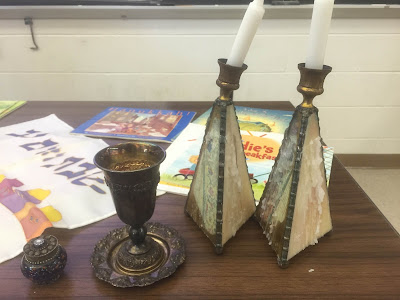Below are the Shabbat candles, wine chalice, and spice holder. These are part of the weekly Shabbat ritual in which the candles are lit to mark the start of Shabbat. This is the Sabbath in Judaism, and is every Friday from sunset, to Saturday at sunset. There are many rituals and guidelines for the 24 hours that Shabbat lasts. The lighting of the candles, which has to be done no later than eighteen minutes before sunset, is known to symbolize multiple things, one being that God created light on the first day of creation, and on the seventh He rested. The Sabbath is the celebration of that rest God took on the seventh day, which is why it is the seventh day of the week on which the Sabbath is always observed. In order to honor and remember the rest, and continue that tradition, there are many stipulations on what can and cannot be done on the Sabbath, for instance; no work or labor of any kind is permitted on the Sabbath. The stipulations further define what should and should not be done. The physicality, or lack thereof, holds much importance to the day and what is being commemorated. Many objects are not to be used, such as anything using electric. What is interesting is the objects that are specifically designated for that day, such as the candles, wine chalice, bread plate, and spice holder. The objects in themselves are not holy but their purpose and meaning hold sacred value.
The table is also set with the bread plate for the two loaves of Challah bread. The bread must be covered by a cloth or napkin. There is a special blessing said for the bread, as with the candles and wine. Synagogue services are attended between the candle lighting and the dinner. This particular bread plate, candles, and chalice, I found in my class specifically on Judaism, while learning about various Jewish holidays. While learning about the meaning behind the holidays and the traditional objects, it is evident that ritual and tradition are a huge part of all special days, as a way of continuing a religion and culture that was nearly exterminated many times in history.

These objects, and other related ritual objects, are representative of, and sacred to the Jewish faith. Though any object could be considered profane, these items do not seem to be as mainstream as some religious paraphernalia. I cannot remember ever seeing things such as the candle holders, wine chalice, and spice holder in any common store. Even if they were more easily acquired, they would still be holy or meaningful to those that believe in the ritual, culture, and faith they represent. They are not common enough for most to recognize and know the purpose or meaning; speaking for myself, I am not even close to understanding and recognizing all that goes into the rituals. Even so, common place things still hold deeper meaning to those that come from a specific background of faith and culture.
Often these items do hold significance not only for religious value, but for tradition, culture and family background. When looking at an article on Jewish homes and what they hold, the women claims that what is in the home really defines it. These objects do not always just maintain ritual purpose, but they show identity. She does not identify as "religious", yet it is very important to her what is in her house. She looks for those distinctions in other homes as well. By some, these objects are even looked at as "boundaries", defining their home from the majority, not in order to shut out the rest of the world, but to set their home apart from it. This woman says how she turned an ordinary wine chalice into a cup for ritual, because she thought it was beautiful. She goes on to say that the material works with the tradition and meaning for her, in order to create a "Jewish Home". She feels these objects clearly mark a Jewish home from a non Jewish home, whether that family is religious or not. Whether for religious reasons, family, culture, or both, objects connected to Judaism and its holidays and traditions are very physical markers of what they do and who they are. Judaism is a religion specifically built on culture and heritage, because it is one that was struggled and fought to maintain for centuries with much turmoil.
Ochs, Vanessa L. "What Makes a Jewish Home Jewish." Cross Currents49.4 (1999/2000). Web. 16 Mar.
2016. <http://www.crosscurrents.org/ochsv.htm>.













